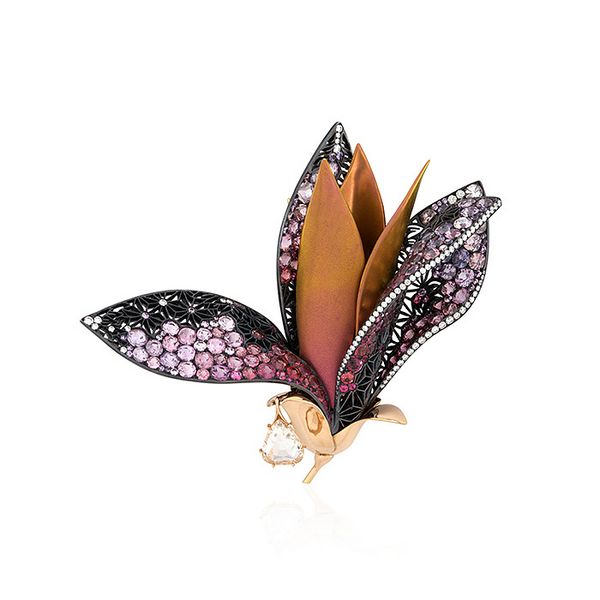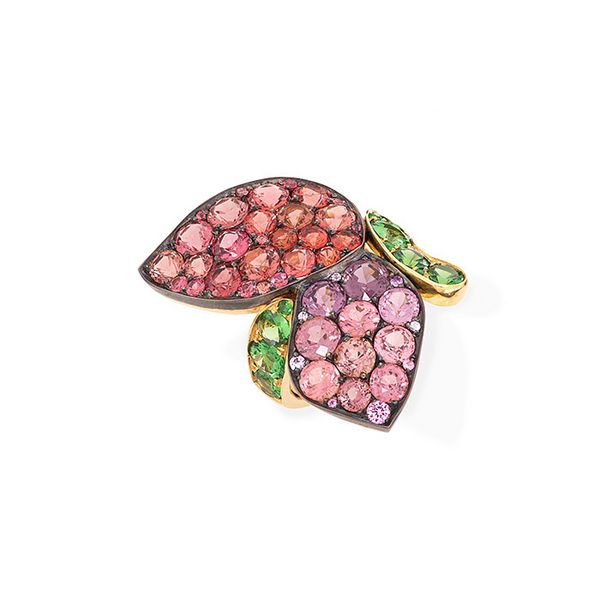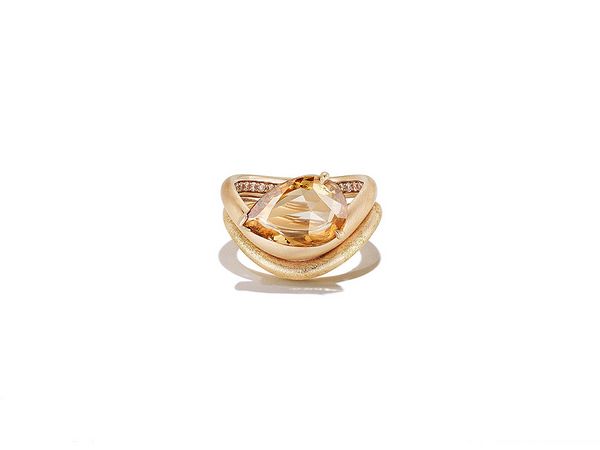Maison Alix Dumas, ‘Bourgeon de Magnolia’ brooch, with spinels, diamonds, and colored sapphires, 2023. Featured in Symbols, Color, and Form.
Focusing on the exciting new jewelry brands of Maison Alix Dumas and DYNE, Symbols, Color and Form is a selling exhibition that runs from 8 to 13 May at Phillips Geneva.
Maison Alix Dumas
Alix Dumas founded Maison Alix Dumas in 2020 in France, between Paris and Brittany.
What drew you to jewelry?
I have always loved jewels, and have been making jewels for as long as I can remember. Yet jewelry wasn't an obvious path for me, and I went to university to study other topics... It finally made me realize that I wanted my passion for jewelry to become my profession. Jewelry combines my love for art and craftsmanship. It is exceptional in that it encompasses the production of a work of art with all the skills it involves, and at the same time its link to the body is a crucial element. As I am a lover of technique and art, jewelry is an amazing field to express myself.
How does your upbringing, heritage, or where you come from impact your vision?
Well, there is too much to say on that topic. My Mother is an art historian and art lover, so museums, exhibitions, artists, have always had a very important role in my upbringing, and later on in my studies. At one point I even have wanted to work in museums and had a summer internship at the Philadelphia Museum of Art working on Renoir... Further, I have lived abroad, mainly in Istanbul, Bucharest, and Seville, getting to discover strong civilizations, art traditions, patterns, and ways of life that forcefully impact on my personal art sphere... I think all these experiences are so much part of who I am that my style is influenced at a deeper level, without having to acknowledge it.
What are your most iconic designs to date — the ones you are really known for? Any unusual stones, combinations, cuts, or techniques?
One signature piece is my Eternity Night ring — a ring covered in sapphires and diamonds, creating a starry night. It has a very contemporary line and volume and a bold link to the body. It is a piece where nothing is hidden, all the usual work of high jewelry on the back of the pieces is here part of the design. There is no front or back.
I love technique, as I said, and have developed some particular traits, like the use of thick metal lace in my designs, creating a pattern in which the eye dives, and which dialogues with stone pavés and color, as you can see for instance on my two Magnolia brooches. Color has a very important part to play in my jewels, and I use gemstones like a painter uses paint strokes.
I would say that my jewels are also distinguishable by the fact that I create them in a sculptor's fashion, directly into space and volume. The dynamic of the piece and how it sits on the body are very important to me.
Maison Alix Dumas, ‘Eclosion’ ring, with spinels, tsavorite garnets, and pink sapphires, 2023. Featured in Symbols, Color, and Form.
How important are traditional jewelry making techniques in your practice?
I am very lucky to be French and to have learned my skill in a famed high jewelry workshop, since we have a very unique tradition. Traditional jewelry making techniques are very important to me, even if I take liberties in how I use them in my designs. It is a base, a pedestal, on which to build excellence. I am all for creativity, but in my opinion, for a piece to be mind-blowing, it has to be well-made and -crafted.
What eras in jewelry (past, present, or future) excite you the most?
It is very difficult for me to choose an era for they are all interesting for different reasons. I would say Antiquity, 19th and early 20th centuries. What I admire are huge royal pieces with "trembleuses" and magnificent old mine diamond paves — there is so much to learn on those! I also love art nouveau pieces for the feeling of liberty, creativity, technicality, and natural inspiration.
What do you want your clients to feel when they wear your jewels?
My jewels are poetical pieces that appeal to the sensibility of their owner. I sculpt them so that they are agreeable to wear. I want people to be driven by the emotion the piece generates for the wearer, be it to feel powerful or soothed — wearing them is an experience, they are a clear comforting presence.
DYNE
Sarah Ysabel Narici founded DYNE in New York in 2021.
DYNE, ‘Nemes’ ring ear cuff, with custom-cut emeralds, 2024. Featured in Symbols, Color, and Form.
What drew you to jewelry?
I spent most of my time as a child drawing. As I developed my ability to draw, I found a style that was particular — I liked focussing on highly detailed, miniature things. Objects that had the ability to tell a story for me were always fascinating too. My grandmother had a glass vitrine functioning as a cabinet of curiosities that I adored looking at.
However, as a teenager, I had aspirations to study law.
Encouraged by my mother, I agreed to visit an art school, and it wasn’t until then that my interest in jewelry was really sparked — I had an instant coup de coeur when I stepped into the jewelry department at Central Saint Martins in London.
How does your upbringing, heritage, or where you come from impact your vision?
The tension between the ancient and the futuristic is a central theme in my work, reflecting my upbringing and cultural influences.
Raised by an Italian father and a British-Singaporean mother, we had an interesting mix of tradition and perspectives.
Growing up in Italy, it was impossible not to absorb culture from bygone eras as you’re surrounded by it. This developed in me a natural curiosity about ancient history.
My father was working with NASA at for a period too. One of my most vivid childhood memories was waiting with unparalleled excitement at the Kennedy Space Center in Florida, during the countdown of the Columbia space shuttle launch. The image of a giant, human-made machine blasting off into space will forever be etched in my mind. This exposure led to many discussions about outer space and the universe , which inevitably had an impact on me.
What are your most iconic designs to date — the ones you are really known for? Any unusual stones, combinations, cuts, or techniques?
The LOVERGLYPHS© pieces are distinct and quite recognizable.
The process of crafting these pieces is an experience which is both collaborative and introspective for every individual I work with.
The pieces seek to capture the human experience, blending elements of permanence and transience to give each piece a unique meaning and significance.
I have a high sensitivity for materials. I enjoy using unusual metal alloys and inlaying different metals together, pairing different colors, transparencies, and textures in unusual ways.
For diamonds, I am drawn to antique shallow cuts, favoring portraits and single-cuts. I love stones to have character and search for specific tones, usually not the traditional ‘D’ color. In colored gemstones, I am using more and more Paraiba tourmalines and Colombian emeralds. Paraiba tourmalines are amongst the rarest stone globally, and market appetite for them is still developing. It is an interesting moment for potential collectors and I believe their value will continue to grow.
DYNE, ‘Cinnamon’ ring and textured band, with a Fancy Yellow Brown diamond, Champagne diamond pavé, and 20K Peach Gold, 2024. Featured in Symbols, Color, and Form.
How important are traditional jewelry making techniques in your practice?
The core process of making jewelry hasn’t changed that much in thousands of years, but extremely skilled artisans are a more and more rare commodity. I work closely with a team of expert craftsmen in New York City who use a mix of traditional learned hand-making techniques and innovative new technology.
What eras in jewelry (past, present, or future) excite you the most?
I look to ancient pieces for inspiration and I’m interested in futuristic materials.
I think my interest in the past is an interest in eternal meaning and beauty — things that existed before us and last beyond us. Every precious object should have that universal beauty, shared among the generations. And then it needs that shiny futuristic element — an exciting glimpse of what is yet to come.
What do you want your clients to feel when they wear your jewels?
I would like them to feel as though they are carrying a little part of their legacy into the future.
Recommended Reading
The Inspired Imagination of Jewelry Designer David Webb >



